Jack Kerouac
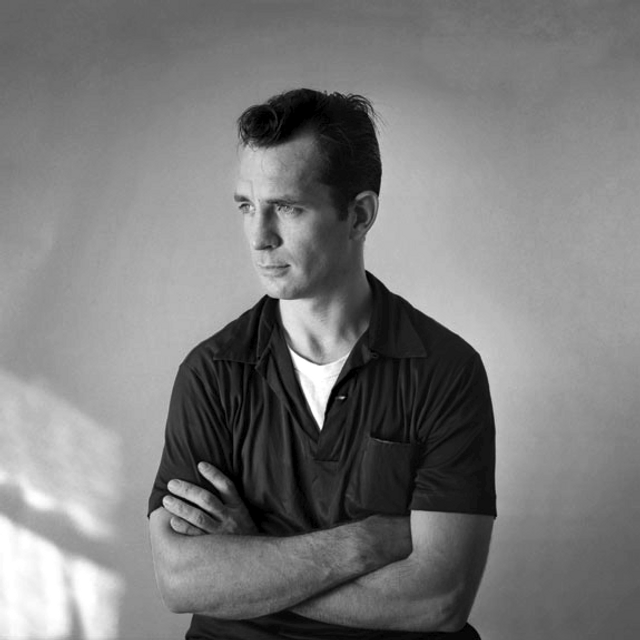
Jack Kerouac

Jack Kerouac | |
|---|---|
| Born | Jean-Louis Kérouac[1] (1922-03-12)March 12, 1922 Lowell, Massachusetts, U.S. |
| Died | October 21, 1969(1969-10-21)(aged 47) St. Petersburg, Florida, U.S. |
| Occupation | Poet, novelist |
| Nationality | American |
| Alma mater | Columbia University |
| Literary movement | Beat |
| Notable works | On the Road The Dharma Bums Big Sur Desolation Angels |
| Spouse | Edie Parker (m. 1944–1948) Joan Haverty (m. 1950–1951) Stella Sampas (m. 1966) |
| Children | Jan Kerouac |
| Signature |  |
He is considered a literary iconoclast and, alongside William S. Burroughs and Allen Ginsberg, a pioneer of the Beat Generation.[7] Kerouac is recognized for his method of spontaneous prose. Thematically, his work covers topics such as Catholic spirituality, jazz, promiscuity, Buddhism, drugs, poverty, and travel. He became an underground celebrity and, with other beats, a progenitor of the hippie movement, although he remained antagonistic toward some of its politically radical elements.[8][9]
In 1969, at age 47, Kerouac died from an abdominal hemorrhage caused by a lifetime of heavy drinking. Since his death, Kerouac's literary prestige has grown, and several previously unseen works have been published. All of his books are in print today, including The Town and the City, On the Road, Doctor Sax, The Dharma Bums, Mexico City Blues, The Subterraneans, Desolation Angels, Visions of Cody, The Sea Is My Brother, and Big Sur.
Jack Kerouac | |
|---|---|
| Born | Jean-Louis Kérouac[1] (1922-03-12)March 12, 1922 Lowell, Massachusetts, U.S. |
| Died | October 21, 1969(1969-10-21)(aged 47) St. Petersburg, Florida, U.S. |
| Occupation | Poet, novelist |
| Nationality | American |
| Alma mater | Columbia University |
| Literary movement | Beat |
| Notable works | On the Road The Dharma Bums Big Sur Desolation Angels |
| Spouse | Edie Parker (m. 1944–1948) Joan Haverty (m. 1950–1951) Stella Sampas (m. 1966) |
| Children | Jan Kerouac |
| Signature |  |
Biography
Early life and adolescence
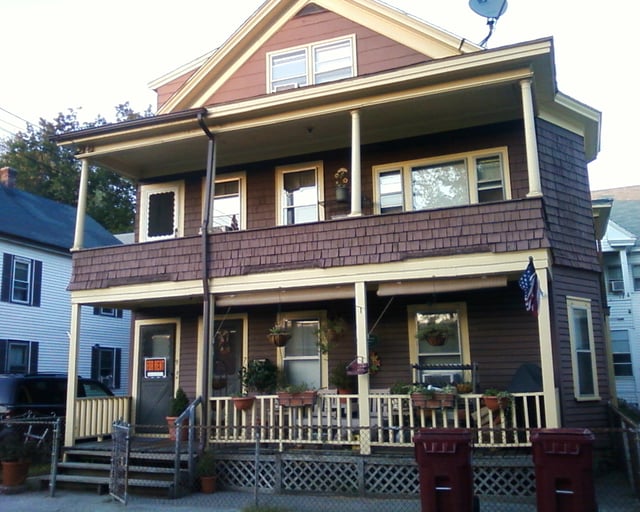
Jack Kerouac's birthplace, 9 Lupine Road, 2nd floor, West Centralville, Lowell, Massachusetts
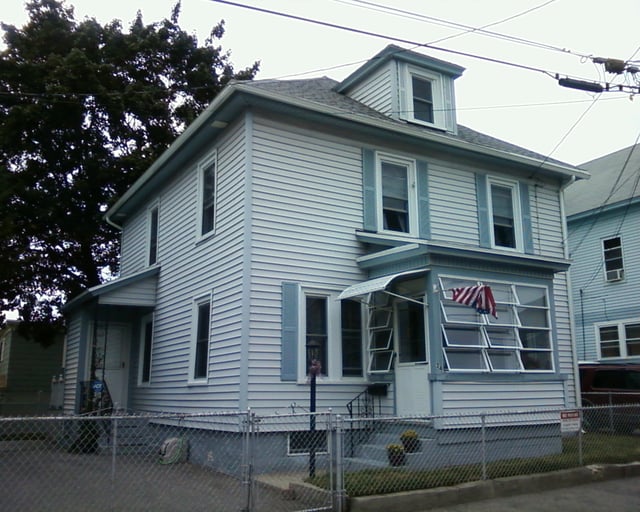
His third of several homes growing up in the West Centralville section of Lowell
Jack Kerouac was born on March 12, 1922 in Lowell, Massachusetts, to French Canadian parents, Léo-Alcide Kéroack (1899–1946) and Gabrielle-Ange Lévesque (1895–1973).[10]
There is some confusion surrounding his name, partly because of variations on the spelling of Kerouac, and because of Kerouac's own statement of his name as Jean-Louis Lebris de Kerouac. His reason for that statement seems to be linked to an old family legend that the Kerouacs had descended from Baron François Louis Alexandre Lebris de Kerouac. Kerouac's baptism certificate lists his name simply as Jean Louis Kirouac, the most common spelling of the name in Quebec.[11] Research has shown that Kerouac's roots were indeed in Brittany, and he was descended from a middle-class merchant colonist, Urbain-François Le Bihan, Sieur de Kervoac, whose sons married French Canadians.[12][13]
Kerouac's father Leo had been born into a family of potato farmers in the village of Saint-Hubert-de-Rivière-du-Loup, Quebec. Jack also had various stories on the etymology of his surname, usually tracing it to Irish, Breton, Cornish or other Celtic roots.
In one interview he claimed it was from the name of the Cornish language (Kernewek) and that the Kerouacs had fled from Cornwall to Brittany.[14] Another version was that the Kerouacs had come to Cornwall from Ireland before the time of Christ and the name meant "language of the house".[15] In still another interview he said it was an Irish word for "language of the water" and related to Kerwick.[16] Kerouac, derived from Kervoach, is the name of a town in Brittany in Lanmeur, near Morlaix.[12]
Jack Kerouac later referred to 34 Beaulieu Street as "sad Beaulieu". The Kerouac family was living there in 1926 when Jack's older brother Gerard died of rheumatic fever, aged nine. This deeply affected four-year-old Jack, who would later say that Gerard followed him in life as a guardian angel. This is the Gerard of Kerouac's novel Visions of Gerard. He had one other sibling, an older sister named Caroline. Kerouac was referred to as Ti Jean or little John around the house during his childhood.[11]
Kerouac spoke French until he began learning English at age six; he did not speak English confidently until his late teens.[17] He was a serious child who was devoted to his mother, who played an important role in his life. She was a devout Catholic, who instilled this deep faith into both her sons.[18] Kerouac would later say that his mother was the only woman he ever loved.[19] After Gerard died, his mother sought solace in her faith, while his father abandoned it, wallowing in drinking, gambling, and smoking.[18]
Some of Kerouac's poetry was written in French, and in letters written to friend Allen Ginsberg towards the end of his life, he expressed a desire to speak his parents' native tongue again. In 2016, a whole volume of previously unpublished works originally written in French by Kerouac was published as La vie est d'hommage.[20][21]
On May 17, 1928, while six years old, Kerouac had his first Confession.[22] For penance, he was told to say a rosary, during which he heard God tell him that he had a good soul, that he would suffer in life and die in pain and horror, but would in the end receive salvation.[22] This experience, along with his dying brother's vision of the Virgin Mary (as the nuns fawned over him, convinced he was a saint), combined with a later study of Buddhism and an ongoing commitment to Christ, solidified the worldview which would inform Kerouac's work.[22]
Kerouac once told Ted Berrigan, in an interview for The Paris Review, of an incident in the 1940s in which his mother and father were walking together in a Jewish neighborhood on the Lower East Side of New York. He recalled "a whole bunch of rabbis walking arm in arm ... teedah- teedah – teedah ... and they wouldn't part for this Christian man and his wife, so my father went POOM! and knocked a rabbi right in the gutter."[23][24] Leo, after the death of his child, also treated a priest with similar contempt, angrily throwing him out of the house despite his invitation from Gabrielle.[18]
Kerouac's athletic skills as a running back in football for Lowell High School earned him scholarship offers from Boston College, Notre Dame, and Columbia University. He entered Columbia University after spending a year at Horace Mann School, where he earned the requisite grades for entry to Columbia. Kerouac broke a leg playing football during his freshman season, and during an abbreviated second year he argued constantly with coach Lou Little, who kept him benched. While at Columbia, Kerouac wrote several sports articles for the student newspaper, the Columbia Daily Spectator, and joined the Phi Gamma Delta fraternity.[25][26] He also studied at The New School.[27]
Early adulthood
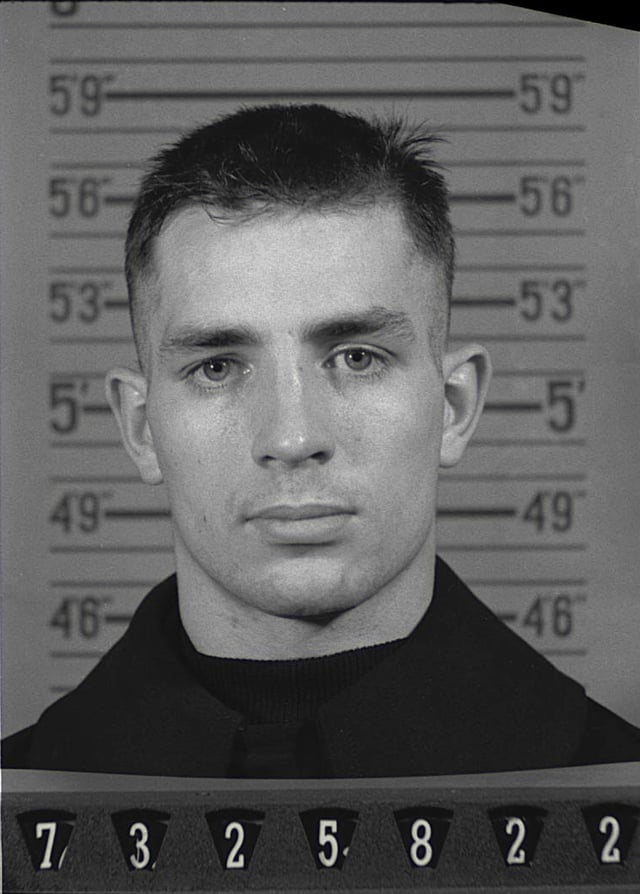
Kerouac's Naval Reserve Enlistment photograph, 1943
When his football career at Columbia ended, Kerouac dropped out of the university. He continued to live for a time in New York's Upper West Side with his girlfriend and future first wife, Edie Parker. It was during this time that he met the Beat Generation people—now famous—with whom he would always be associated, and who as characters formed the basis of many of his novels, including Allen Ginsberg, Neal Cassady, John Clellon Holmes, Herbert Huncke, Lucien Carr and William S. Burroughs.
Kerouac joined the United States Merchant Marine in 1942 and in 1943 joined the United States Navy, but served only eight days of active duty before arriving on the sick list. According to his medical report, Kerouac said he "asked for an aspirin for his headaches and they diagnosed me dementia praecox and sent me here." The medical examiner reported that Kerouac's military adjustment was poor, quoting Kerouac: "I just can't stand it; I like to be by myself." Two days later he was honorably discharged on psychiatric grounds (he was of "indifferent character" with a diagnosis of "schizoid personality").[28]
While serving in the United States Merchant Marine, Kerouac wrote his first novel The Sea Is My Brother. Although written in 1942, the book was not published until 2011, some 42 years after Kerouac's death and 70 years after it was written. Kerouac described the work as being about "man's simple revolt from society as it is, with the inequalities, frustration, and self-inflicted agonies." He viewed the work as a failure, calling it a "crock as literature", and he never actively sought to publish it.[29]
In 1944, Kerouac was arrested as a material witness in the murder of David Kammerer, who had been stalking Kerouac's friend Lucien Carr since Carr was a teenager in St. Louis. William Burroughs was also a native of St. Louis, and it was through Carr that Kerouac came to know both Burroughs and Allen Ginsberg. According to Carr, Kammerer's homosexual obsession turned aggressive, finally provoking Carr to stab him to death in self-defense. Carr dumped the body in the Hudson River. Afterwards, Carr sought help from Kerouac. Kerouac disposed of the murder weapon and buried Kammerer's eyeglasses. Carr, encouraged by Burroughs, turned himself in to the police. Kerouac and Burroughs were later arrested as material witnesses. Kerouac's father refused to pay his bail. Kerouac then agreed to marry Edie Parker if her parents would pay the bail. (Their marriage was annulled in 1948.)[30] Kerouac and Burroughs collaborated on a novel about the Kammerer killing entitled And the Hippos Were Boiled in Their Tanks. Though the book was not published during their lifetimes, an excerpt eventually appeared in Word Virus: The William S. Burroughs Reader (and as noted below, the novel was finally published late 2008). Kerouac also later wrote about the killing in his novel Vanity of Duluoz.
Later, Kerouac lived with his parents in the Ozone Park neighborhood of Queens, after they had also moved to New York. He wrote his first published novel, The Town and the City, and began the famous On the Road around 1949 when living there.[31] His friends jokingly called him "The Wizard of Ozone Park", alluding to Thomas Edison's nickname, "the Wizard of Menlo Park", and to the film The Wizard of Oz.[32]
Early career: 1950–1957

Jack Kerouac lived with his parents for a time above a corner drug store in Ozone Park (now a flower shop),[33] while writing some of his earliest work.
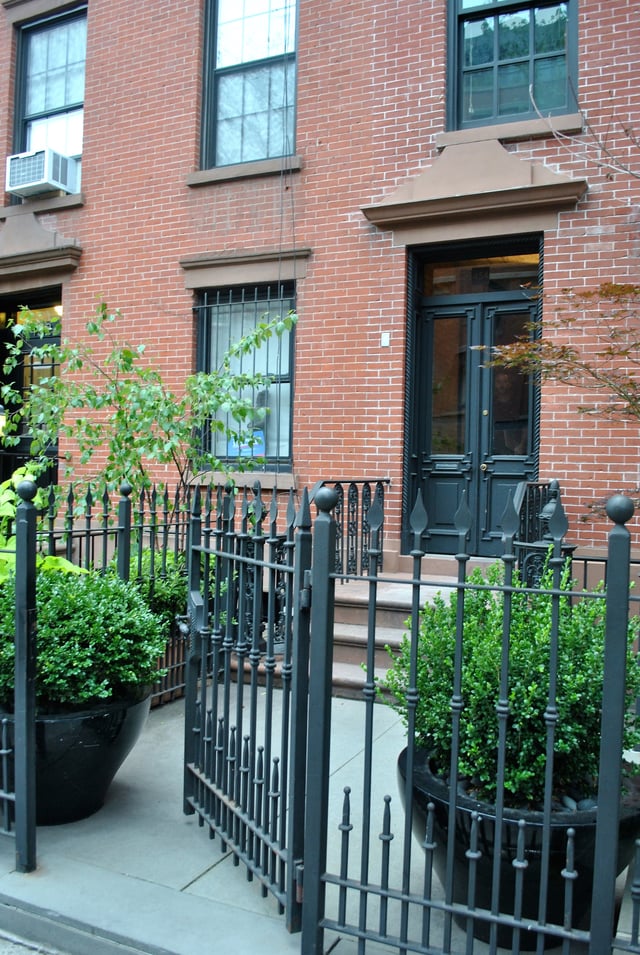
454 West 20th Street

House in College Park in Orlando, Florida where Kerouac lived and wrote The Dharma Bums
The Town and the City was published in 1950 under the name "John Kerouac" and, though it earned him a few respectable reviews, the book sold poorly. Heavily influenced by Kerouac's reading of Thomas Wolfe, it reflects on the generational epic formula and the contrasts of small town life versus the multi-dimensional, and larger life of the city. The book was heavily edited by Robert Giroux, with around 400 pages taken out.
For the next six years, Kerouac continued to write regularly. Building upon previous drafts tentatively titled "The Beat Generation" and "Gone on the Road," Kerouac completed what is now known as On the Road in April 1951, while living at 454 West 20th Street in Manhattan with his second wife, Joan Haverty.[34] The book was largely autobiographical and describes Kerouac's road-trip adventures across the United States and Mexico with Neal Cassady in the late 40s and early 50s, as well as his relationships with other Beat writers and friends. He completed the first version of the novel during a three-week extended session of spontaneous confessional prose. Kerouac wrote the final draft in 20 days, with Joan, his wife, supplying him with benzedrine, cigarettes, bowls of pea soup and mugs of coffee to keep him going.[35] Before beginning, Kerouac cut sheets of tracing paper[36] into long strips, wide enough for a typewriter, and taped them together into a 120-foot (37 m) long roll which he then fed into the machine. This allowed him to type continuously without the interruption of reloading pages. The resulting manuscript contained no chapter or paragraph breaks and was much more explicit than the version which would eventually be published. Though "spontaneous," Kerouac had prepared long in advance before beginning to write.[37] In fact, according to his Columbia professor and mentor Mark Van Doren, he had outlined much of the work in his journals over the several preceding years.
Though the work was completed quickly, Kerouac had a long and difficult time finding a publisher. Before On the Road was accepted by Viking Press, Kerouac got a job as a "railroad brakeman and fire lookout" (see Desolation Peak (Washington)) traveling between the East and West coasts of the United States to earn money, frequently finding rest and the quiet space necessary for writing at the home of his mother. While employed in this way he met and befriended Abe Green, a young freight train jumper who later introduced Kerouac to Herbert Huncke, a Times Square street hustler and favorite of many Beat Generation writers. During this period of travel, Kerouac wrote what he considered to be "his life's work": Vanity of Duluoz.[38] Between 1955-1956, he lived on and off with his sister, whom he called "Nin," and her husband, Paul Blake, at their home outside of Rocky Mount, N.C. ("Testament, Va." in his works) where he meditated on, and studied, Buddhism.[39] He wrote Some of the Dharma, an imaginative treatise on Buddhism, while living there.[40][41]
Publishers rejected On the Road because of its experimental writing style and its sexual content. Many editors were also uncomfortable with the idea of publishing a book that contained what were, for the era, graphic descriptions of drug use and homosexual behavior—a move that could result in obscenity charges being filed, a fate that later befell Burroughs' Naked Lunch and Ginsberg's Howl.
According to Kerouac, On the Road "was really a story about two Catholic buddies roaming the country in search of God. And we found him. I found him in the sky, in Market Street San Francisco (those 2 visions), and Dean (Neal) had God sweating out of his forehead all the way. THERE IS NO OTHER WAY OUT FOR THE HOLY MAN: HE MUST SWEAT FOR GOD. And once he has found Him, the Godhood of God is forever Established and really must not be spoken about."[18] According to his biographer, historian Douglas Brinkley, On the Road has been misinterpreted as a tale of companions out looking for kicks, but the most important thing to comprehend is that Kerouac was an American Catholic author – for example, virtually every page of his diary bore a sketch of a crucifix, a prayer, or an appeal to Christ to be forgiven.[42]
In the spring of 1951, while pregnant, Joan Haverty left and divorced Kerouac.[43] In February 1952, she gave birth to Kerouac's only child, Jan Kerouac, though he refused to acknowledge her as his daughter until a blood test confirmed it 9 years later.[44] For the next several years Kerouac continued writing and traveling, taking long trips through the U.S. and Mexico. He often experienced episodes of heavy drinking and depression. During this period, he finished drafts of what would become ten more novels, including The Subterraneans, Doctor Sax, Tristessa, and Desolation Angels, which chronicle many of the events of these years.
In 1953, he lived mostly in New York City, having a brief but passionate affair with an African-American woman. This woman was the basis for the character named "Mardou" in the novel The Subterraneans. At the request of his editors, Kerouac changed the setting of the novel from New York to San Francisco.
In 1954, Kerouac discovered Dwight Goddard's A Buddhist Bible at the San Jose Library, which marked the beginning of his study of Buddhism. However, Kerouac had earlier taken an interest in Eastern thought. In 1946 he read Heinrich Zimmer's Myths and Symbols in Indian Art and Civilization. In 1955, Kerouac wrote a biography of Siddhartha Gautama, titled Wake Up: A Life of the Buddha, which was unpublished during his lifetime, but eventually serialized in Tricycle: The Buddhist Review, 1993–95. It was published by Viking in September 2008.[45]
Kerouac found enemies on both sides of the political spectrum, the right disdaining his association with drugs and sexual libertinism and the left contemptuous of his anti-communism and Catholicism; characteristically, he watched the 1954 Senate McCarthy hearings smoking marijuana and rooting for the anti-communist crusader, Senator Joseph McCarthy.[18] In Desolation Angels he wrote, "when I went to Columbia all they tried to teach us was Marx, as if I cared" (considering Marxism, like Freudianism, to be an illusory tangent).[46]
In 1957, after being rejected by several other publishers, On the Road was finally purchased by Viking Press, which demanded major revisions prior to publication.[37] Many of the more sexually explicit passages were removed and, fearing libel suits, pseudonyms were used for the book's "characters." These revisions have often led to criticisms of the alleged spontaneity of Kerouac's style.[36]
Later career: 1957–1969
In July 1957, Kerouac moved to a small house at 1418½ Clouser Avenue in the College Park section of Orlando, Florida, to await the release of On the Road. Weeks later, a review of the book by Gilbert Millstein appeared in The New York Times proclaiming Kerouac the voice of a new generation.[47] Kerouac was hailed as a major American writer. His friendship with Allen Ginsberg, William S. Burroughs and Gregory Corso, among others, became a notorious representation of the Beat Generation. The term Beat Generation was invented by Kerouac during a conversation held with fellow novelist Herbert Huncke. Huncke used the term "beat" to describe a person with little money and few prospects.[48] "I'm beat to my socks", he had said. Kerouac's fame came as an unmanageable surge that would ultimately be his undoing.
Kerouac's novel is often described as the defining work of the post-World War II Beat Generation and Kerouac came to be called "the king of the beat generation,"[49] a term with which he never felt comfortable. He once observed, "I'm not a beatnik. I'm a Catholic", showing the reporter a painting of Pope Paul VI and saying, "You know who painted that? Me."[50]
The success of On the Road brought Kerouac instant fame. His celebrity status brought publishers desiring unwanted manuscripts that were previously rejected before its publication.[19] After nine months, he no longer felt safe in public. He was badly beaten by three men outside the San Remo Cafe at 189 Bleecker Street in New York City one night. Neal Cassady, possibly as a result of his new notoriety as the central character of the book, was set up and arrested for selling marijuana.[51][52]
In response, Kerouac chronicled parts of his own experience with Buddhism, as well as some of his adventures with Gary Snyder and other San Francisco-area poets, in The Dharma Bums, set in California and Washington and published in 1958. It was written in Orlando between November 26[53] and December 7, 1957.[54] To begin writing Dharma Bums, Kerouac typed onto a ten-foot length of teleprinter paper, to avoid interrupting his flow for paper changes, as he had done six years previously for On the Road.[53]
Kerouac was demoralized by criticism of Dharma Bums from such respected figures in the American field of Buddhism as Zen teachers Ruth Fuller Sasaki and Alan Watts. He wrote to Snyder, referring to a meeting with D.T. Suzuki, that "even Suzuki was looking at me through slitted eyes as though I was a monstrous imposter." He passed up the opportunity to reunite with Snyder in California, and explained to Philip Whalen "I'd be ashamed to confront you and Gary now I've become so decadent and drunk and don't give a shit. I'm not a Buddhist any more."[55] In further reaction to their criticism, he quoted part of Abe Green's café recitation, Thrasonical Yawning in the Abattoir of the Soul: "A gaping, rabid congregation, eager to bathe, are washed over by the Font of Euphoria, and bask like protozoans in the celebrated light." Many consider that this clearly indicated Kerouac's journey on an emotional roller coaster of unprecedented adulation and spiritual demoralization.
Kerouac also wrote and narrated a beat movie titled Pull My Daisy (1959), directed by Robert Frank and Alfred Leslie. It starred poets Allen Ginsberg and Gregory Corso, musician David Amram and painter Larry Rivers among others.[56] Originally to be called The Beat Generation, the title was changed at the last moment when MGM released a film by the same name in July 1959 that sensationalized beatnik culture.
The television series Route 66 (1960–1964), featuring two untethered young men "on the road" in a Corvette seeking adventure and fueling their travels by apparently plentiful temporary jobs in the various U.S. locales framing the anthology-styled stories, gave the impression of being a commercially sanitized misappropriation of Kerouac's story model for On the Road.[57] Even the leads, Buz and Todd, bore a resemblance to the dark, athletic Kerouac and the blonde Cassady/Moriarty, respectively. Kerouac felt he'd been conspicuously ripped off by Route 66 creator Stirling Silliphant and sought to sue him, CBS, the Screen Gems TV production company, and sponsor Chevrolet, but was somehow counseled against proceeding with what looked like a very potent cause of action.[57]
John Antonelli's 1985 documentary Kerouac, the Movie begins and ends with footage of Kerouac reading from On the Road and Visions of Cody on The Steve Allen Plymouth Show in November 1959. Kerouac appears intelligent but shy. "Are you nervous?" asks Steve Allen. "Naw," says Kerouac, sweating and fidgeting.[58]
In 1965, he met the poet Youenn Gwernig who was a Breton American like him in New York, and they became friends. Gwernig used to translate his Breton language poems in English in order to make Kerouac read and understand them : "Meeting with Jack Kerouac in 1965, for instance, was a decisive turn. Since he could not speak Breton he asked me : 'Would you not write some of your poems in English? I'd really like to read them ! ... ' So I wrote an Diri Dir – Stairs of Steel for him, and kept on doing so. That's why I often write my poems in Breton, French and English."[59]
In the following years, Kerouac suffered the loss of his older sister to a heart attack in 1964 and his mother suffered a paralyzing stroke in 1966. In 1968, Neal Cassady also died while in Mexico.[60]
Also in 1968, he appeared on the television show Firing Line produced and hosted by William F. Buckley Jr. (a friend of Kerouac's from his college years). Kerouac talked about the counterculture of the 1960s in what would be his last appearance on television.[61]
Death
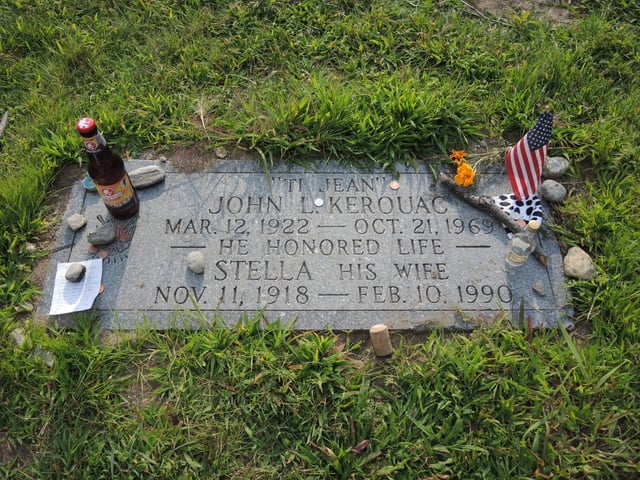
Grave in Edson Cemetery, Lowell
At eleven o'clock, on the morning of October 20, 1969, in St. Petersburg, Florida, Kerouac was sitting in his favorite chair drinking whiskey and malt liquor, working on a book about his father's print shop in Lowell, Massachusetts. He suddenly felt nauseated and walked to the bathroom, where he began to vomit blood. Kerouac was taken to a nearby hospital, suffering from an esophageal hemorrhage. He received several transfusions in an attempt to make up for the loss of blood, and doctors subsequently attempted surgery, but a damaged liver prevented his blood from clotting. He died at 5:15 the following morning at St. Anthony's Hospital, never having regained consciousness after the operation. His cause of death was listed as an internal hemorrhage (bleeding esophageal varices) caused by cirrhosis, the result of longtime alcohol abuse.[62][63] A possible contributing factor was an untreated hernia he suffered in a bar fight several weeks earlier.[64][65][66] He is buried at Edson Cemetery, Lowell, Massachusetts.[67]
At the time of his death, he was living with his third wife, Stella Sampas Kerouac, and his mother Gabrielle. Kerouac's mother inherited most of his estate.
He was honored posthumously with a Doctor of Letters degree from his hometown University of Massachusetts Lowell on June 2, 2007.[68]
Style
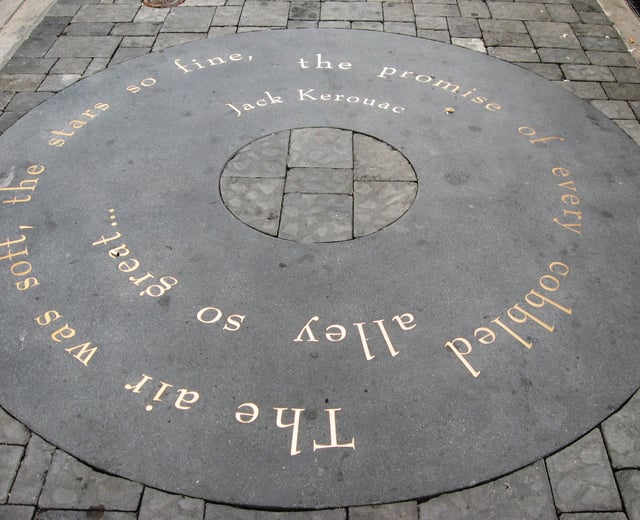
On the Road excerpt in the center of Jack Kerouac Alley
Kerouac is generally considered to be the father of the Beat movement, although he actively disliked such labels. Kerouac's method was heavily influenced by the prolific explosion of jazz, especially the Bebop genre established by Charlie Parker, Dizzy Gillespie, Thelonious Monk, and others. Later, Kerouac included ideas he developed from his Buddhist studies that began with Gary Snyder. He often referred to his style as "spontaneous prose."[69] Although Kerouac's prose was spontaneous and purportedly without edits, he primarily wrote autobiographical novels (or roman à clef) based upon actual events from his life and the people with whom he interacted.
Many of his books exemplified this spontaneous approach, including On the Road, Visions of Cody, Visions of Gerard, Big Sur, and The Subterraneans. The central features of this writing method were the ideas of breath (borrowed from jazz and from Buddhist meditation breathing), improvising words over the inherent structures of mind and language, and limited revision. Connected with this idea of breath was the elimination of the period, substituting instead a long connecting dash. As such, the phrases occurring between dashes might resemble improvisational jazz licks. When spoken, the words take on a certain musical rhythm and tempo.
Kerouac greatly admired and was influenced by Gary Snyder. The Dharma Bums contains accounts of a mountain climbing trip Kerouac took with Snyder, and includes excerpts of letters from Snyder.[70] While living with Snyder outside Mill Valley, California, in 1956, Kerouac worked on a book about him, which he considered calling Visions of Gary.[71] (This eventually became Dharma Bums, which Kerouac described as "mostly about [Snyder].")[72] That summer, Kerouac took a job as a fire lookout on Desolation Peak in the North Cascades in Washington, after hearing Snyder's and Whalen's stories of working as fire spotters. On Desolation Peak he'd hoped to "come face to face with God or Tathagata and find out once and for all what is the meaning of all this existence. But instead I'd come face to face with myself ... and many's the time I thought I'd die of boredom or jump off the mountain."[73] Kerouac described the experience in Desolation Angels and later in The Dharma Bums".
Kerouac would go on for hours, often drunk, to friends and strangers about his method. Allen Ginsberg, initially unimpressed, would later be one of his great proponents, and it was Kerouac's free-flowing prose method that inspired the composition of Ginsberg's poem Howl. It was at about the time of The Subterraneans that he was encouraged by Ginsberg and others to formally explain his style. Of his expositions of the Spontaneous Prose method, the most concise was Belief and Technique for Modern Prose, a list of 30 "essentials".
... and I shambled after as usual as I've been doing all my life after people who interest me, because the only people for me are the mad ones, the ones who are mad to live, mad to talk, mad to be saved, desirous of everything at the same time, the ones who never yawn or say a commonplace thing, but burn, burn, burn like fabulous yellow roman candles exploding like spiders across the stars and in the middle you see the blue centerlight pop and everybody goes "Awww!" —On the Road
Although the body of Kerouac's work has been published in English, recent research has shown that, in addition to his poetry and letters to friends and family, he also wrote unpublished works of fiction in French. All these works, including La nuit est ma femme, Sur le chemin, and large sections of Maggie Cassidy (originally written in French), have now been published together in a volume entitled La vie est d'hommage (Boréal, 2016) edited by University of Pennsylvania professor Jean-Christophe Cloutier. In 1996, the Nouvelle Revue Française published excerpts and an article on "La nuit est ma femme", and scholar Paul Maher Jr., in his biography Kerouac: His Life and Work', discussed Sur le chemin's plot and characters. The novella, completed in five days in Mexico during December 1952, is a telling example of Kerouac's attempts at writing in his first language, a language he often called Canuck French. Kerouac refers to this short novel in a letter addressed to Neal Cassady (who is commonly known as the inspiration for the character Dean Moriarty) dated January 10, 1953. The published novel runs over 110 pages, having been reconstituted from six distinct files in the Kerouac archive by Professor Cloutier. Set in 1935, mostly on the East Coast, it explores some of the recurring themes of Kerouac's literature by way of a spoken word narrative. Here, as with most of his French writings, Kerouac writes with little regard for grammar or spelling, often relying on phonetics in order to render an authentic reproduction of the French-Canadian vernacular. Even though this work has the same title as one of his best known English novels, it is the original French version of an incomplete translation that would later become Old Bull in the Bowery (now published in The Unknown Kerouac from the Library of America).[76] The Unknown Kerouac, edited by Todd Tietchen, includes Cloutier's translation of La nuit est ma femme and the completed translation of Sur le Chemin under the title Old Bull in the Bowery. La nuit est ma femme was written in early 1951 and completed a few days or weeks before he began the original English version of On the Road, as many scholars, such as Paul Maher Jr., Joyce Johnson, Hassan Melehy, and Yannis Livadas[77] have pointed out.
Influences
Kerouac's early writing, particularly his first novel The Town and the City, was more conventional, and bore the strong influence of Thomas Wolfe. The technique Kerouac developed that later made him famous was heavily influenced by jazz, especially Bebop, and later, Buddhism, as well as the famous Joan Anderson letter written by Neal Cassady.[78] The Diamond Sutra was the most important Buddhist text for Kerouac, and "probably one of the three or four most influential things he ever read".[79] In 1955, he began an intensive study of this sutra, in a repeating weekly cycle, devoting one day to each of the six Pāramitās, and the seventh to the concluding passage on Samādhi. This was his sole reading on Desolation Peak, and he hoped by this means to condition his mind to emptiness, and possibly to have a vision.[80]
An often overlooked[81] literary influence on Kerouac was James Joyce, whose work he alludes to more than any other author.[82] Kerouac had high esteem for Joyce and he often used Joyce's stream-of-consciousness technique.[82][83] Regarding On the Road, he wrote in a letter to Ginsberg, "I can tell you now as I look back on the flood of language. It is like Ulysses and should be treated with the same gravity."[84] Additionally, Kerouac admired Joyce's experimental use of language, as seen in his novel Visions of Cody, which uses an unconventional narrative as well as a multiplicity of authorial voices.[85]
Legacy
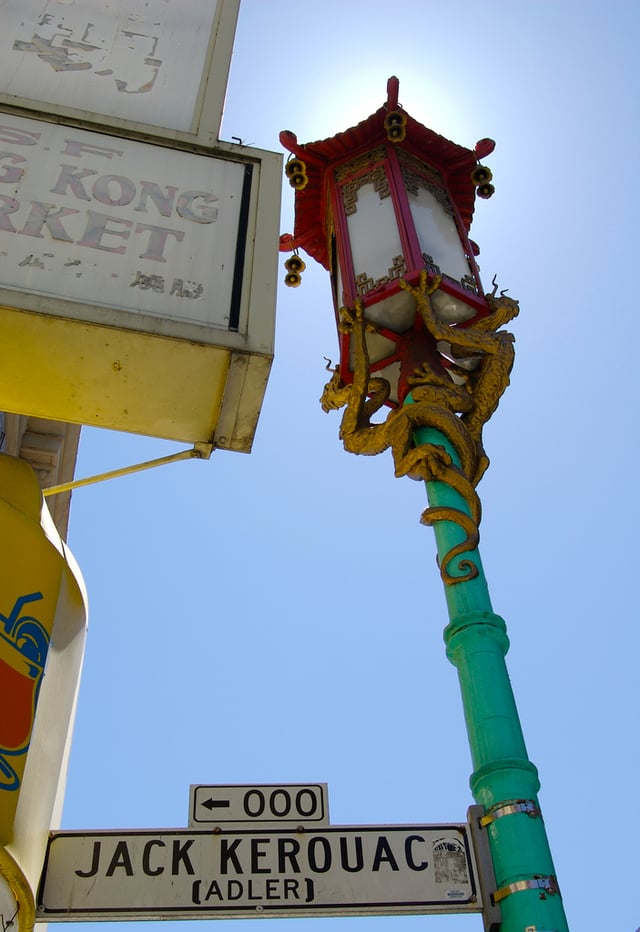
Jack Kerouac Alley in Chinatown, San Francisco
Jack Kerouac and his literary works had a major impact on the popular rock music of the 1960s. Artists including Bob Dylan, the Beatles, Patti Smith, Tom Waits, the Grateful Dead, and The Doors all credit Kerouac as a significant influence on their music and lifestyles. This is especially so with members of the band The Doors, Jim Morrison and Ray Manzarek who quote Jack Kerouac and his novel On the Road as one of the band's greatest influences.[86] In his book Light My Fire: My Life with The Doors, Ray Manzarek (keyboard player of The Doors) wrote "I suppose if Jack Kerouac had never written On the Road, The Doors would never have existed." The alternative rock band 10,000 Maniacs wrote a song bearing his name, "Hey Jack Kerouac" on their 1987 album In My Tribe. The 2000 Barenaked Ladies song, Baby Seat, from the album Maroon, references Kerouac.[87]
In 1974, the Jack Kerouac School of Disembodied Poetics was opened in his honor by Allen Ginsberg and Anne Waldman at Naropa University, a private Buddhist university in Boulder, Colorado. The school offers a BA in Writing and Literature, MFAs in Writing & Poetics and Creative Writing, and a summer writing program.[88]
From 1978 to 1992, Joy Walsh published 28 issues of a magazine devoted to Kerouac, Moody Street Irregulars.
Kerouac's French-Canadian origins inspired a 1987 National Film Board of Canada docudrama Jack Kerouac's Road: A Franco-American Odyssey, directed by Acadian poet Herménégilde Chiasson.[89]
In the mid-1980s, Kerouac Park was placed in downtown Lowell, Massachusetts.[90]
A street, rue de Jack Kérouac, is named after him in Quebec City, as well as in the hamlet of Kerouac, Lanmeur, Brittany. An annual Kerouac festival was established in Lanmeur in 2010.[91] In the 1980s, the city of San Francisco named a one-way street, Jack Kerouac Alley, in his honor in Chinatown.
In 1997, the house on Clouser Avenue where The Dharma Bums was written was purchased by a newly formed non-profit group, The Jack Kerouac Writers in Residence Project of Orlando, Inc. This group provides opportunities for aspiring writers to live in the same house in which Kerouac was inspired, with room and board covered for three months. In 1998, the Chicago Tribune published a story by journalist Oscar J. Corral that described a simmering legal dispute between Kerouac's family and the executor of daughter Jan Kerouac's estate, Gerald Nicosia. The article, citing legal documents, showed that Kerouac's estate, worth only $91 at the time of his death, was worth $10 million in 1998.
In 2007, Kerouac was awarded a posthumous honorary degree from the University of Massachusetts Lowell.[92]
In 2009, the movie One Fast Move or I'm Gone – Kerouac's Big Sur was released. It chronicles the time in Kerouac's life that led to his novel Big Sur, with actors, writers, artists, and close friends giving their insight into the book. The movie also describes the people and places on which Kerouac based his characters and settings, including the cabin in Bixby Canyon. An album released to accompany the movie, "One Fast Move or I'm Gone", features Benjamin Gibbard (Death Cab for Cutie) and Jay Farrar (Son Volt) performing songs based on Kerouac's Big Sur.
In 2010, during the first weekend of October, the 25th anniversary of the literary festival "Lowell Celebrates Kerouac" was held in Kerouac's birthplace of Lowell, Massachusetts. It featured walking tours, literary seminars, and musical performances focused on Kerouac's work and that of the Beat Generation.
In the 2010s, there has been a surge in films based on the Beat Generation. Kerouac has been depicted in the films Howl and Kill Your Darlings. A feature film version of On the Road was released internationally in 2012, and was directed by Walter Salles and produced by Francis Ford Coppola. Independent filmmaker Michael Polish directed Big Sur, based on the novel, with Jean-Marc Barr cast as Kerouac. The film was released in 2013.[93][94]
A species of Indian platygastrid wasp that is phoretic (hitch-hiking) on grasshoppers is named after him as Mantibaria kerouaci.[95]
Works
Poetry
While he is best known for his novels, Kerouac is also noted for his poetry. Kerouac said that he wanted "to be considered as a jazz poet blowing a long blues in an afternoon jazz session on Sunday.".[96] Many of Kerouac's poems follow the style of his free-flowing, uninhibited prose, also incorporating elements of jazz and Buddhism. "Mexico City Blues," a collection of poems published in 1959, is made up of 242 choruses following the rhythms of jazz. In much of his poetry, to achieve a jazz-like rhythm, Kerouac made use of the long dash in place of a period. Several examples of this can be seen in "Mexico City Blues":
Everything Is Ignorant of its own emptiness— Anger Doesnt like to be reminded of fits—
— fragment from 113th Chorus[97]
Other well-known poems by Kerouac, such as "Bowery Blues," incorporate jazz rhythms with Buddhist themes of Saṃsāra, the cycle of life and death, and Samadhi, the concentration of composing the mind.[98] Also, following the jazz / blues tradition, Kerouac's poetry features repetition and themes of the troubles and sense of loss experienced in life.
Posthumous editions
In 2007, to coincide with the 50th anniversary of *On the Road'*s publishing, Viking issued two new editions: On the Road: The Original Scroll, and On the Road: 50th Anniversary Edition.[99][100] By far the more significant is Scroll, a transcription of the original draft typed as one long paragraph on sheets of tracing paper which Kerouac taped together to form a 120-foot (37 m) scroll. The text is more sexually explicit than Viking allowed to be published in 1957, and also uses the real names of Kerouac's friends rather than the fictional names he later substituted. Indianapolis Colts owner Jim Irsay paid $2.43 million for the original scroll and allowed an exhibition tour that concluded at the end of 2009. The other new issue, 50th Anniversary Edition, is a reissue of the 40th anniversary issue under an updated title.
Les Éditions du Boréal, a Montreal-based publishing house, obtained rights from Kerouac's estate to publish a collection of works titled La vie est d'hommage (it was released in April 2016). It includes 16 previously unpublished works, in French, including a novella, Sur le chemin, La nuit est ma femme, and large sections of Maggie Cassidy originally written in French. Both Sur le chemin and La nuit est ma femme have also been translated to English by Jean-Christophe Cloutier, in collaboration with Kerouac, and were published in 2016 by the Library of America in The Unknown Kerouac.[103][104]
Discography
Studio albums
Poetry for the Beat Generation (with Steve Allen) (1959)
Blues and Haikus (with Al Cohn and Zoot Sims) (1959)
Readings by Jack Kerouac on the Beat Generation (1960)
Compilation albums
The Jack Kerouac Collection (1990) [Box] (Audio CD collection of three studio albums)
Jack Kerouac Reads On the Road (1999)
